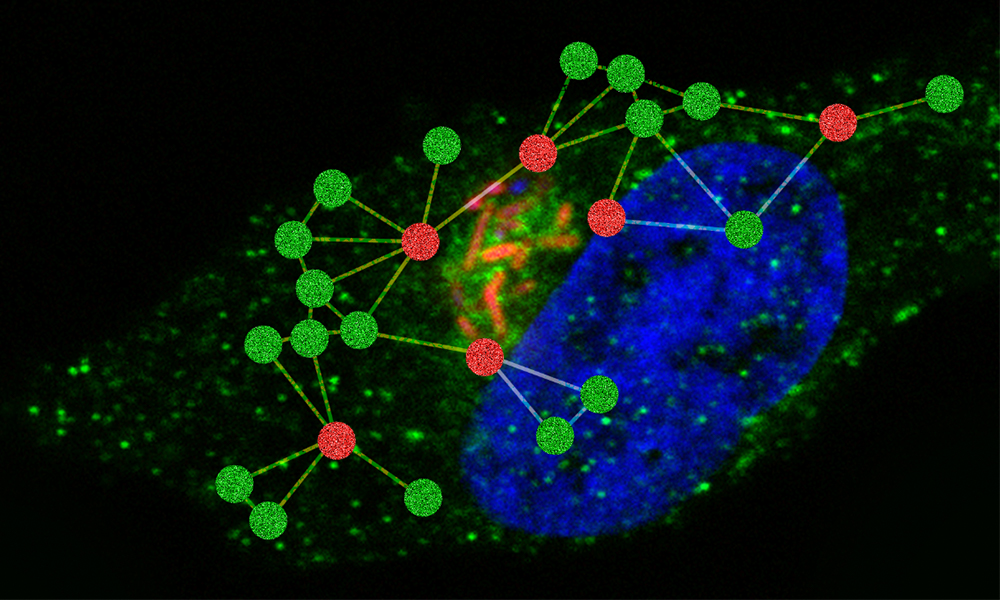EMBL scientists shed light on how Salmonella hijacks the machinery of its host cell to promote its own growth and reproduction

Our cells fight microbial invaders by engulfing them into membrane sacs - hostile environments in which pathogens are rapidly destroyed. However, the pathogen Salmonella enterica, which grows and reproduces inside our cells, has evolved ways to detoxify such hostile compartments, turning them into a comfortable home where Salmonella can survive and thrive.
A team of scientists led by EMBL group leader Nassos Typas has uncovered new details of Salmonella's survival strategies. The researchers analysed protein interactions in Salmonella-infected cells to identify the diverse biological processes of the host cell that the bacterium uses. Salmonella targets and modifies cellular protein machineries and pathways, in which multiple proteins work together, with the help of so-called effector proteins, which it injects into host cells. Altogether, Salmonella is known to release more than 30 effector proteins into infected cells to hijack nutrients and protect itself. However, the functions of many of these proteins, and which host cell proteins they interact with, are largely unknown.
To find these enigmatic protein interactions, the EMBL scientists genetically engineered 32 Salmonella strains by adding identification tags to individual Salmonella proteins - earmarking one protein in each bacterial strain. The identification tags act like a handle the scientists can grab in their experiments. This approach of modifying the effector proteins directly in their host is a breakthrough. It enables researchers to capture the bacterial proteins after they have been secreted into infected cells, and to pull them out along with any host cell proteins that are bound to them. These interacting proteins are then identified using a technique called mass spectrometry. "The new approach has many benefits over previous experimental strategies. In particular, it characterises the whole set of host-pathogen protein-protein interactions in cells infected with a live pathogen, closely resembling what occurs in a host organism upon Salmonella infection," says Joel Selkrig, a scientist in the Typas group and one of the two lead authors of the study.
Using their novel approach, the EMBL scientists identified 421 previously unknown interactions between Salmonella proteins and host cell proteins - along with 25 interactions that had been described before.
"We found that multiple Salmonella effectors physically interact with several proteins that the host cell uses to transport cholesterol. This way, cholesterol trafficking can be hijacked for Salmonella's own purposes," says Philipp Walch, who recently completed his PhD at EMBL Heidelberg and shares first authorship of the study with Joel.
Cholesterol is an essential component of the biological membranes that surround our cells and the structures within them. Salmonella uses cholesterol to modify the composition of the membrane sacs that surround it, potentially making the membrane more rigid and reinforcing the barrier that separates Salmonella from cellular detection and defence systems, which are present in the host cell's cytoplasm.
The scientists also found new clues to how two other survival strategies work. One of these strategies is to remodel the network of protein fibres that are used to transport material within the cell. Another strategy involves interfering with the function of a host cell protein that mediates contacts between membranes to facilitate the exchange of lipids and small molecules. Both strategies may help Salmonella to strengthen its protective membrane shield and avoid detection by the host cell's defence systems.
The recent results follow research published by the Typas group in 2020, in which the researchers described how Salmonella infection can lead to an inflammatory form of cell death. The current study involved scientists from EMBL and colleagues from Imperial College London, UK; the Helmholtz Centre for Infection Research in Braunschweig, Germany; and Rocky Mountain Laboratories in Hamilton, Montana, USA - part of the National Institute of Allergy and Infectious Diseases.






